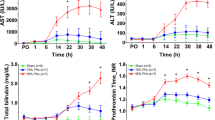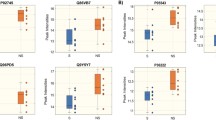Abstract
Hemorrhagic shock with injury results in alterations of the metabolic state of an organism, which contribute to organ dysfunction and death. Previous investigations have explored the effects of carbohydrate prefeed in murine models but few in clinically relevant large animal models. We performed carbohydrate prefeed in pigs undergoing simulated polytrauma and hemorrhagic shock with resuscitation to determine if carbohydrate prefeeding if the metabolic response to shock is dependent on fed state. Sixty-four Yorkshire pigs were divided into two experimental groups: fasted (32) and prefed (32). Experimental animals were subjected to a standardized hemorrhagic shock protocol, including pulmonary contusion and liver crush injury. To determine molecular alterations in response to trauma as a result of prefeeding, liver biopsies were obtained at set timepoints throughout the procedure. Fifty-one metabolites were profiled for each sample via proton nuclear magnetic resonance spectroscopy (1H NMR). Partial-Least Squared Discriminant Analysis (PLS-DA) was used to examine clustering of the data with respect to fed state. Cross-validated models separated the fed from fasted animals. Metabolites contributing to the separation have known relationships to alternate carbon energy sources, amino acid metabolism, oxidative stress response, and membrane maintenance. In conclusion, metabolomic techniques allowed identification of an alternate response to shock and resuscitation, dependent upon fed state, through the use of metabolomics.



Similar content being viewed by others
References
Bijlsma, S., et al. (2006). Large-scale human metabolomics studies: A strategy for data (pre-) processing and validation. Analytical Chemistry, 78, 567–574.
Dubick, M. A. (2011). Current concepts in fluid resuscitation for prehospital care of combat casualties. U.S. Army Medical Department Journal, 5–6, 18–24.
Eastridge, B. J., et al. (2012). Death on the battlefield (2001–2011): Implications for the future of combat casualty care. Journal of Trauma and Acute Care Surgery, 73, S431–S437.
Eisenberg, D., Gill, H. S., Pfluegl, G. M. U., & Rotstein, S. H. (2000). Structure–function relationships of glutamine synthetases. Biochimica et Biophysica Acta (BBA), 1477, 122–145.
Elias-Miró, M., Elias-Miró, M., Bibiana Jiménez-Castro, M., Rodés, J., & Peralta, C. (2013). Current knowledge on oxidative stress in hepatic ischemia/reperfusion. Free Radical Research, 47(8), 555–568. doi:10.3109/10715762.2013.811721.
Guinzberg, R., et al. (2006). Inosine released after hypoxia activates hepatic glucose liberation through A3 adenosine receptors. American Journal of Physiology, 290, E940–E951.
Hoberman, H. D., & Prosky, L. (1967). Evidence of reduction of fumarate to succinate in perfused rat liver under conditions of reduced O2 tension. Biochimica et Biophysica Acta (BBA)-General Subjects, 148(2), 392–399.
Holcomb, J. B., Stansbury, L. G., Champion, H. R., Wade, C., & Bellamy, R. F. (2006). Understanding combat casualty care statistics. Journal of Trauma, 60, 397–401.
Holcomb, J. B., et al. (1999). Effect of dry fibrin sealant dressings versus gauze packing on blood loss in grade V liver injuries in resuscitated swine. Journal of Trauma, 46, 49–57.
Holcomb, J., et al. (2007). Causes of death in US Special Operations Forces in the global war on terrorism: 2001-2004. U.S. Army Medical Department Journal, 4–46, 24–37.
Iyegha, U. P., et al. (2012). Does the fed state impact outcome in polytrauma and hemorrhagic shock? Journal of the American College of Surgeons, 215, S52.
Kooij, A., Schiller, H. J., Schijns, M., Van Noorden, C. J. F., & Frederiks, W. M. (1994). Conversion of xanthine dehydrogenase into xanthine oxidase in rat liver and plasma at the onset of reperfusion after ischemia. Hepatology, 19, 1488–1495.
Lexcen, D. R., Lusczek, E. R., Witowski, N. E., Mulier, K. E., & Beilman, G. J. (2012). Metabolomics classifies phase of care and identifies risk for mortality in a porcine model of multiple injuries and hemorrhagic shock. Journal of Trauma and Acute Care Surgery, 73, S147–S155.
Liland, K. H. (2011). Multivariate methods in metabolomics—from pre-processing to dimension reduction and statistical analysis. Trends in Analytical Chemistry, 30, 827–841.
Lusczek, E. R., Lexcen, D. R., Witowski, N. E., Mulier, K. E., & Beilman, G. (2013). Urinary metabolic network analysis in trauma, hemorrhagic shock, and resuscitation. Metabolomics, 9, 223–235.
McNelis, J., et al. (2001). Prolonged lactate clearance is associated with increased mortality in the surgical intensive care unit. American Journal of Surgery, 182, 481–485.
Nicholson, J. K., Lindon, J. C., & Holmes, E. (1999). ‘Metabonomics’: Understanding the metabolic responses of living systems to pathophysiological stimuli via multivariate statistical analysis of biological nmr spectroscopic data. Xenobiotica, 29, 1181–1189.
Nissen, S., et al. (2000). β-Hydroxy-β-Methylbutyrate (HMB) Supplementation in humans is safe and may decrease cardiovascular risk factors. Journal of Nutrition, 130, 1937–1945.
Orman, M. A., Androulakis, I. P., Berthiaume, F., & Ierapetritou, M. G. (2012). Metabolic network analysis of perfused livers under fed and fasted states: Incorporating thermodynamic and futile-cycle-associated regulatory constraints. Journal of Theoretical Biology, 293, 101–110.
Orman, M. A., Ierapetritou, M. G., Androulakis, I. P., & Berthiaume, F. (2013). Effect of fasting on the metabolic response of liver to experimental burn injury. Public Library Of Science ONE, 8, e54825.
Paulin, A., Droillard, M. J., & Bureau, J. M. (1986). Effect of a free radical scavenger, 3,4,5-trichlorophenol, on ethylene production and on changes in lipids and membrane integrity during senescence of petals of cut carnations (Dianthus caryophyllus). Plant Physiology, 67, 465–471.
Putri, S. P., et al. (2013). Current metabolomics: Practical applications. Journal of Bioscience and Bioengineering, 115, 579–589.
R Core Team. (2013). R: A Language and Environment for Statistical Computing. http://www.R-project.org/. Accessed 1 Dec 2013.
Sanchez, G. (2012). DiscriMiner: Tools of the Trade for Discriminant Analysis. http://CRAN.R-project.org/package=DiscriMiner. Accessed 1 Dec 2013.
Scribner, D. M., et al. (2010). Liver metabolomic changes identify biochemical pathways in hemorrhagic shock. Journal of Surgical Research, 164, e131–e139.
Simpson, G. L. (2012). permute: Functions for generating restricted permutations of data. R package version 0.7-0. http://CRAN.R-project.org/package=permute. Accessed 1 Dec 2013.
Snodgrass, P. J., Lin, R. C., Müller, W. A., & Aoki, T. T. (1978). Induction of urea cycle enzymes of rat liver by glucagon. Journal of Biological Chemistry, 253, 2748–2753.
Spinella, P. C., & Holcomb, J. B. (2009). Resuscitation and transfusion principles for traumatic hemorrhagic shock. Blood Review, 23, 231–240.
Szymanska, E., Saccenti, E., Smilde, A. K., & Westerhuis, J. A. (2012). Double-check: Validation of diagnostic statistics for PLS-DA models in metabolomics studies. Metabolomics, 8, 3–16.
Trygg, J., Holmes, E., & Lundstedt, T. (2007). Chemometrics in metabonomics. Journal of Proteome Research, 6, 469–479.
Tyagi, R. K., Azrad, A., Degani, H., & Salomon, Y. (1996). Simultaneous extraction of cellular lipids and water-soluble metabolites: Evaluation by NMR spectroscopy. Magnetic Resonance in Medicine, 35, 194–200.
Voelckel, W. G., et al. (2003). Arginine vasopressin, but not epinephrine, improves survival in uncontrolled hemorrhagic shock after liver trauma in pigs*. Critical Care Medicine, 31, 1160–1165.
Weitzman, S. A., & Stossel, T. P. (1982). Effects of oxygen radical scavengers and antioxidants on phagocyte-induced mutagenesis. Journal of Immunology, 128, 2770–2772.
Weljie, A. M., Newton, J., Mercier, P., Carlson, E., & Slupsky, C. M. (2006). Targeted profiling: Quantitative analysis of 1H NMR metabolomics data. Analytical Chemistry, 78, 4430–4442.
Westerhuis, J. A., et al. (2008). Assessment of PLSDA cross validation. Metabolomics, 4, 81–89.
Zhang, S., et al. (1997). Effect of endogenous adenosine augmentation on ischemia and reperfusion injury to the liver. Transplantation Proceedings, 29, 1336–1337.
Acknowledgments
The study was supported by the Office of Naval Research (N00014-09-1-0323) and the University of Minnesota.
Author information
Authors and Affiliations
Corresponding author
Electronic supplementary material
Below is the link to the electronic supplementary material.
Rights and permissions
About this article
Cite this article
Determan, C.E., Lusczek, E.R., Witowski, N.E. et al. Carbohydrate fed state alters the metabolomic response to hemorrhagic shock and resuscitation in liver. Metabolomics 10, 950–957 (2014). https://doi.org/10.1007/s11306-014-0621-6
Received:
Accepted:
Published:
Issue Date:
DOI: https://doi.org/10.1007/s11306-014-0621-6




